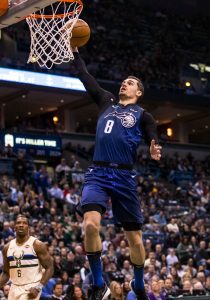After a period of virtually unprecedented stability in the NBA’s head coaching ranks, the coaching carousel started spinning again during the 2017/18 league year. Three teams made in-season coaching changes, installing interim replacements, and six more clubs have parted ways with their head coaches since the regular season ended.
In the space below, we’ll provide daily updates on the head coaching searches for each club that has yet to give anyone the permanent title. Some of these searches could extend well into the spring, so be sure to check back each day for the latest updates.
Updated 6-12-18 (10:32am CT)
Active Searches:
None
Completed Searches:
Atlanta Hawks
- Out: Mike Budenholzer (story)
- In: Lloyd Pierce (story)
- After initially giving Budenholzer permission to interview with other teams seeking a new head coach, the Hawks and Budenholzer reached an agreement to mutually part ways, leaving Atlanta on the lookout for a new coach of its own. After three meetings with him, the Hawks made Pierce their man.
- Interviewed: Nate Tibbetts (story), Stephen Silas (story), Jay Larranaga (story), Jarron Collins (story), Darvin Ham (story), David Fizdale (hired by Knicks)
Charlotte Hornets
- Out: Steve Clifford (story)
- In: James Borrego (story)
- In addition to firing Clifford, the Hornets made a change in their front office this offseason, hiring Mitch Kupchak as their new president of basketball operations and general manager. Kupchak led the search for a new head coach, and Borrego was the team’s choice.
- Interviewed: Jay Larranaga (story; second interview), Jerry Stackhouse (story), Ettore Messina (story), David Fizdale (story), Ime Udoka (story), David Vanterpool (story), Jim Boylen (story), Nick Nurse (story)
Detroit Pistons
- Out: Stan Van Gundy (story)
- In: Dwane Casey (story)
- The Pistons were said to like Ime Udoka, John Beilein, and Kenny Smith, but Casey always appeared to be the frontrunner. The team finalized a deal with him before hiring a new general manager.
- Interviewed or will interview: Kenny Smith (story), Juwan Howard (story), Ime Udoka (story), John Beilein (story), Jason Kidd (story), Nick Nurse (story)
- Rumored target before he was hired by another team: Mike Budenholzer (story)
Memphis Grizzlies
- Out: David Fizdale (in-season change)
- In: J.B. Bickerstaff (story)
- J.B. Bickerstaff, who finished the 2017/18 season as the Grizzlies’ interim head coach, was elevated to the permanent role after Robert Pera retained control of the franchise. Bickerstaff and the Grizzlies agreed to a new three-year contract that includes a team option in year three.
Milwaukee Bucks
- Out: Jason Kidd (in-season change); Joe Prunty (interim coach)
- In: Mike Budenholzer (story)
- Even before he parted ways with the Hawks, Budenholzer was rumored to have interest in the Bucks’ head coaching job. The Bucks considered other candidates – including finalist Ettore Messina – and Budenholzer received interest from other teams, but the two sides ultimately came together, agreeing to a four-year deal.
- Interviewed: Joe Prunty (story), Ettore Messina (story), Steve Clifford (story), Monty Williams (story), David Blatt (story), Becky Hammon (story), Jay Larranaga (story)
- Informal conversation: Jim Cleamons (story)
- Had planned to interview: James Borrego (story)
New York Knicks
- Out: Jeff Hornacek (story)
- In: David Fizdale (story)
- The Knicks cast a wide net as they searched for a new head coach, meeting with current and former head coaches, assistants, and even a TV analyst with no previous coaching experience. In total, they interviewed 11 candidates, ultimately landing on Fizdale, who agreed to a four-year contract with the club.
- Interviewed: Jerry Stackhouse (story), Mark Jackson (story), Mike Woodson (story), Kenny Smith (story), Mike Budenholzer (story), David Blatt (story; second meeting), James Borrego (story), Jay Larranaga (story), Juwan Howard (story), Mike Brown (story)
Orlando Magic
- Out: Frank Vogel (story)
- In: Steve Clifford (story)
- The Magic said after firing Vogel that they planned to take their time with their search, and they made good on that promise, taking nearly seven weeks to pick a replacement. Ultimately, it was Clifford, a former Orlando assistant on Stan Van Gundy‘s staff, who emerged as the choice, reaching a four-year deal to join the Magic.
- Interviewed: David Vanterpool (story), Ime Udoka (story), Kelvin Sampson (story), David Fizdale (story; hired by Knicks)
Phoenix Suns
- Out: Earl Watson (in-season change); Jay Triano (interim coach)
- In: Igor Kokoskov (story)
- The Suns talked about conducting a “wide-ranging” head coaching search, and they delivered on that promise, talking to at least at least 10 candidates. Ultimately, they decided on Jazz assistant Igor Kokoskov, who becomes the first European-born NBA head coach.
- Interviewed: David Fizdale (story), Frank Vogel (story), Steve Clifford (story), Vinny Del Negro (story), James Borrego (story), Nick Nurse (story), Chris Finch (story), Jason Kidd (story), Mike Budenholzer (interviewed; withdrew from consideration)
Toronto Raptors
- Out: Dwane Casey (story)
- In: Nick Nurse (story)
- Setting a franchise record for wins in a season (59) and winning the Coaches Association’s Coach of the Year award didn’t save Casey’s job, with the Raptors dismissing him in what Masai Ujiri called “a very difficult but necessary step.” Nurse, a top assistant who was credited for revamping Toronto’s offense last season, received a promotion to the top job.
- Interviewed: Rex Kalamian (story), Jerry Stackhouse (story), Ettore Messina (story), Ime Udoka (story), Sarunas Jasikevicius (story), Mike Budenholzer (story; hired by Bucks)
